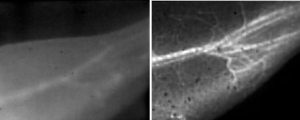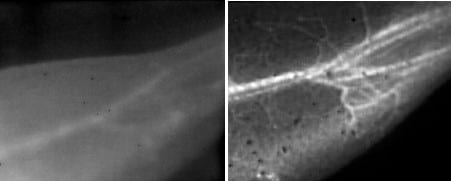Stanford scientists have developed a fluorescence imaging technique that allows them to view the pulsing blood vessels of living animals with unprecedented clarity. Compared with conventional imaging techniques, the increase in sharpness is akin to wiping fog off your glasses.
The technique, called near infrared-II imaging, or NIR-II, involves first injecting water-soluble carbon nanotubes into the living subject’s bloodstream.

These images of a mouse’s blood vessels show the difference in resolution between traditional near-infrared fluorescence imaging (left) and Stanford’s new NIR-II technique (right).
The researchers then shine a laser (its light is in the near-infrared range, a wavelength of about 0.8 micron) over the subject; in this case, a mouse.
The light causes the specially designed nanotubes to fluoresce at a longer wavelength of 1-1.4 microns, which is then detected to determine the blood vessels’ structure.
That the nanotubes fluoresce at substantially longer wavelengths than conventional imaging techniques is critical in achieving the stunningly clear images of the tiny blood vessels: longer wavelength light scatters less, and thus creates sharper images of the vessels. Another benefit of detecting such long wavelength light is that the detector registers less background noise since the body does not does not produce autofluorescence in this wavelength range.
In addition to providing fine details, the technique – developed by Stanford scientists Hongjie Dai, professor of chemistry; John Cooke, professor of cardiovascular medicine; and Ngan Huang, acting assistant professor of cardiothoracic surgery – has a fast image acquisition rate, allowing researchers to measure blood flow in near real time.
The ability to obtain both blood flow information and blood vessel clarity was not previously possible, and will be particularly useful in studying animal models of arterial disease, such as how blood flow is affected by the arterial blockages and constrictions that cause, among other things, strokes and heart attacks.
“For medical research, it’s a very nice tool for looking at features in small animals,” Dai said. “It will help us better understand some vasculature diseases and how they respond to therapy, and how we might devise better treatments.”
Because NIR-II can only penetrate a centimeter, at most, into the body, it won’t replace other imaging techniques for humans, but it will be a powerful method for studying animal models by replacing or complementing X-ray, CT, MRI and laser Doppler techniques.
The next step for the research, and one that will make the technology more easily accepted for use in humans, is to explore alternative fluorescent molecules, Dai said. “We’d like to find something smaller than the carbon nanotubes but that emit light at the same long wavelength, so that they can be easily excreted from the body and we can eliminate any toxicity concerns.”
Source: Stanford University

















